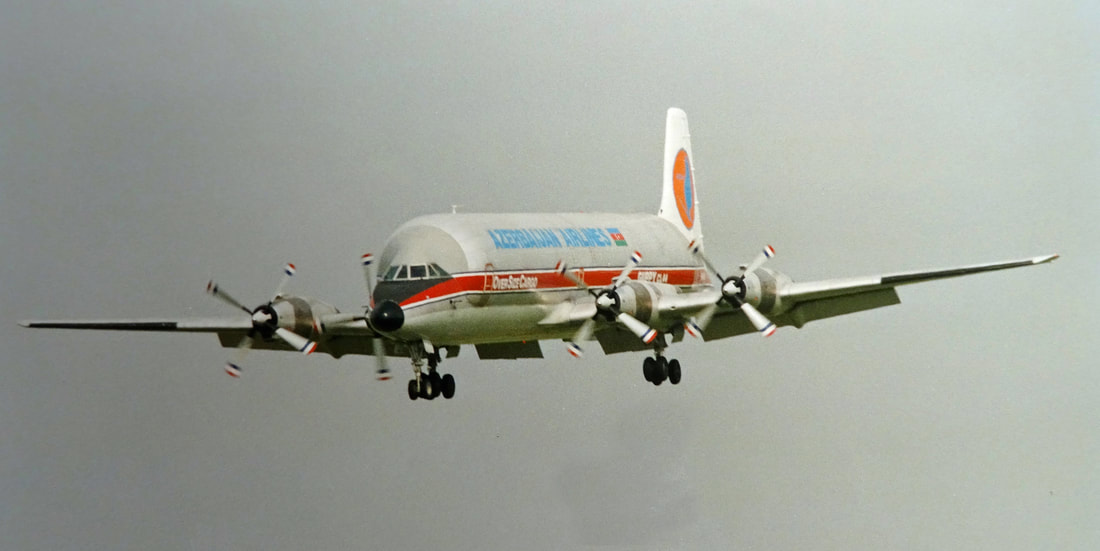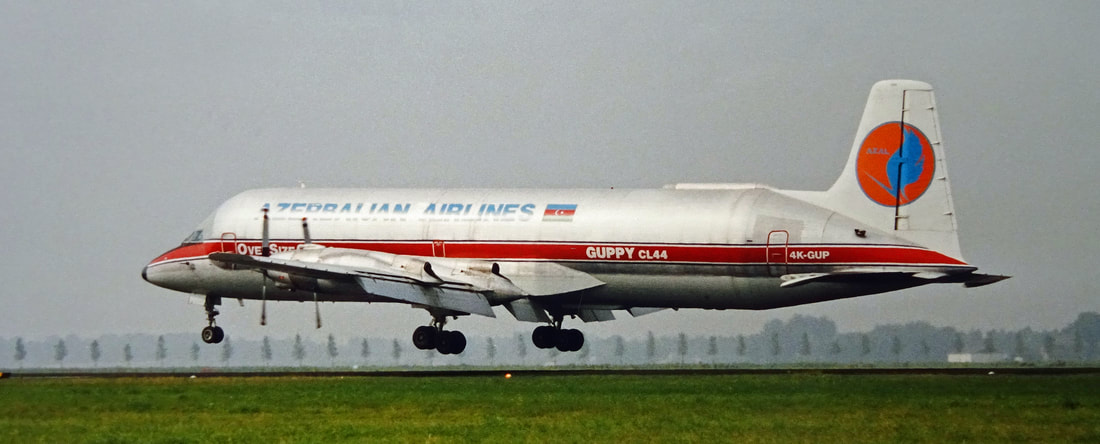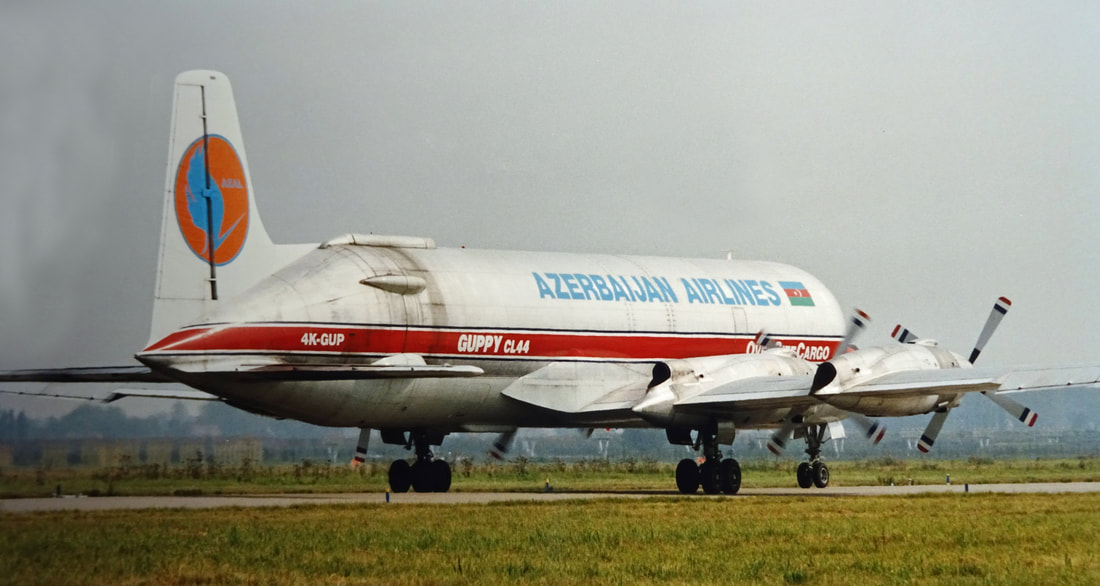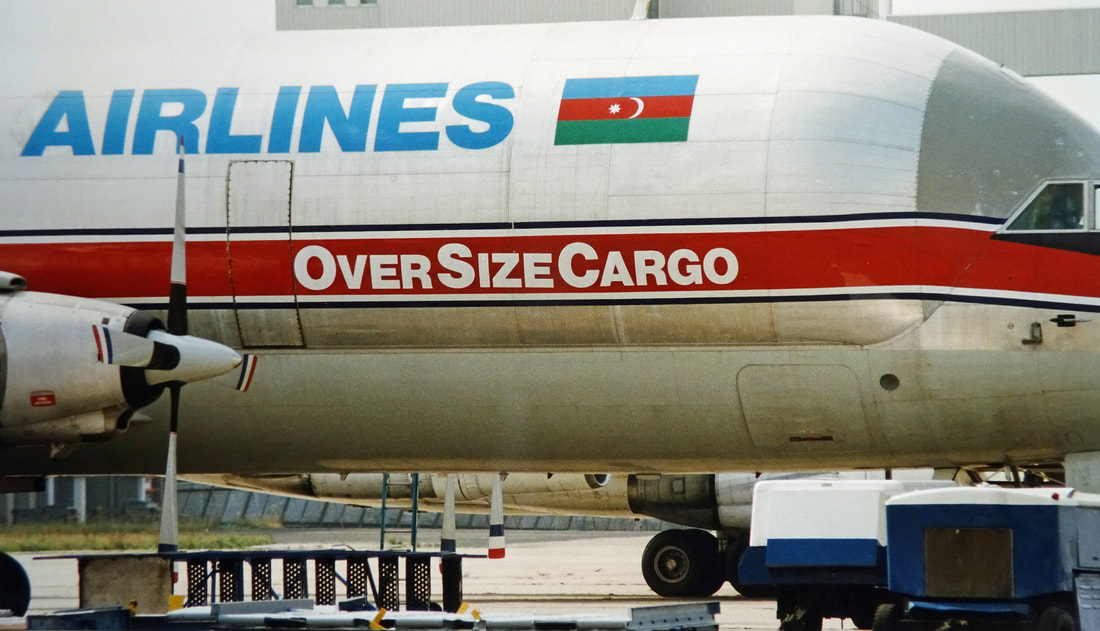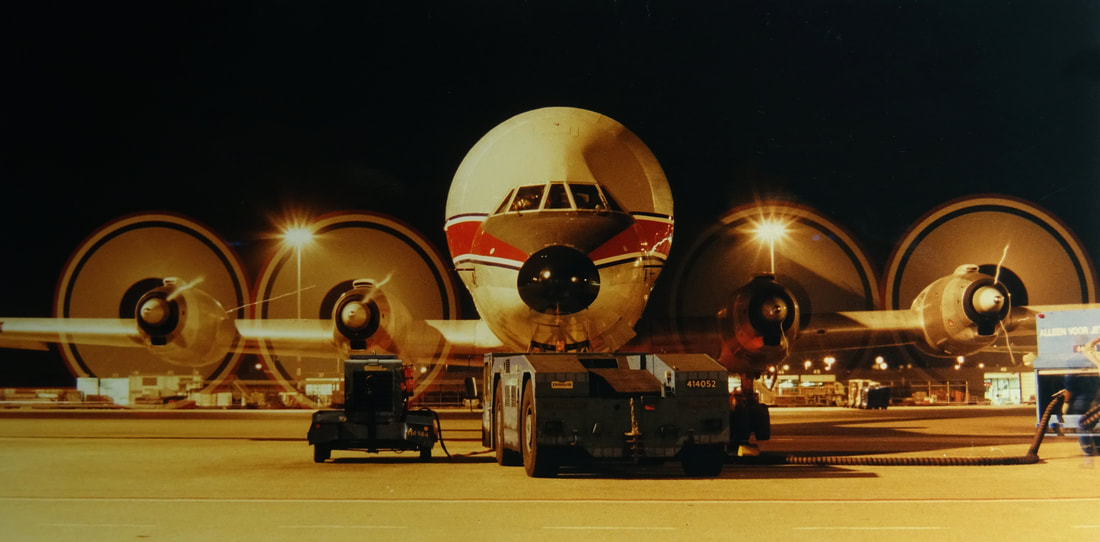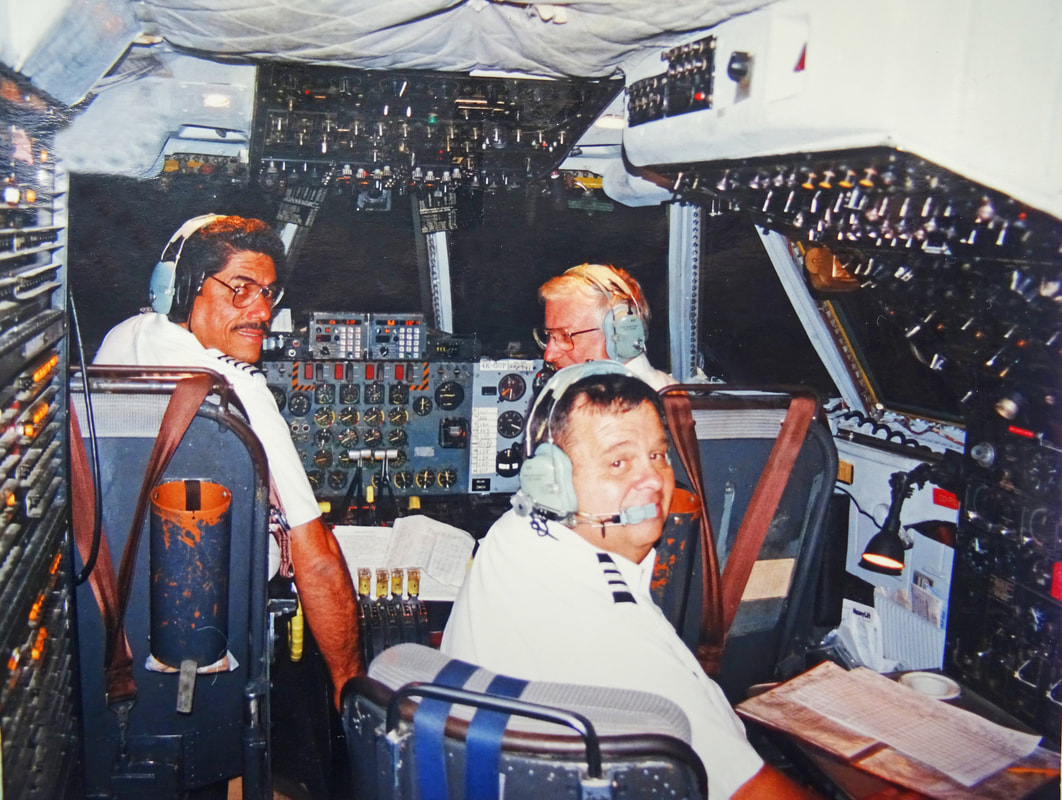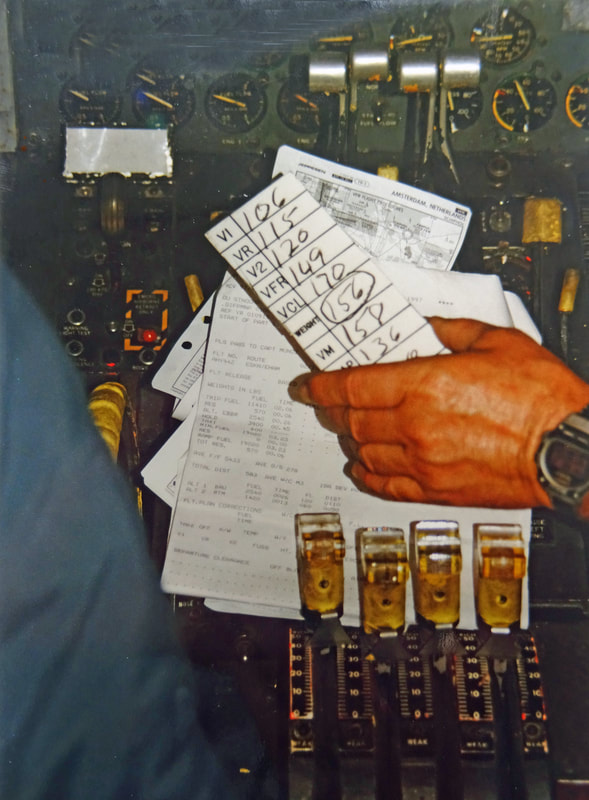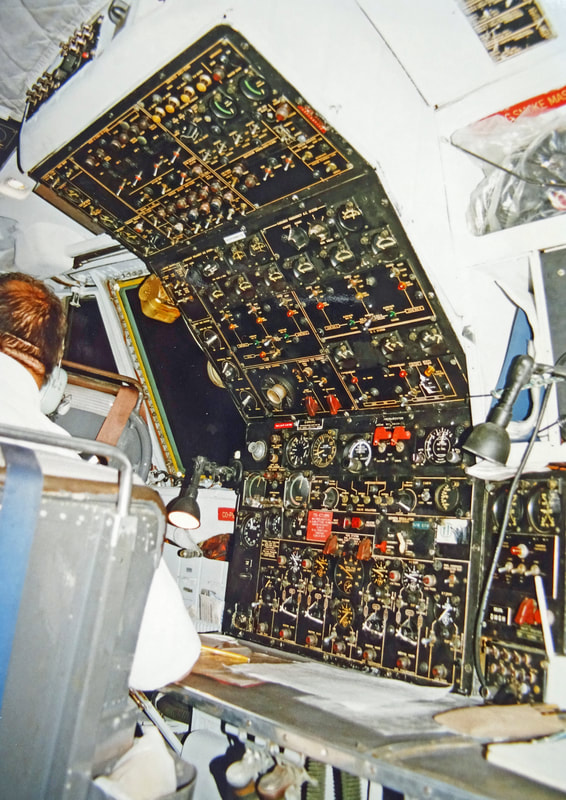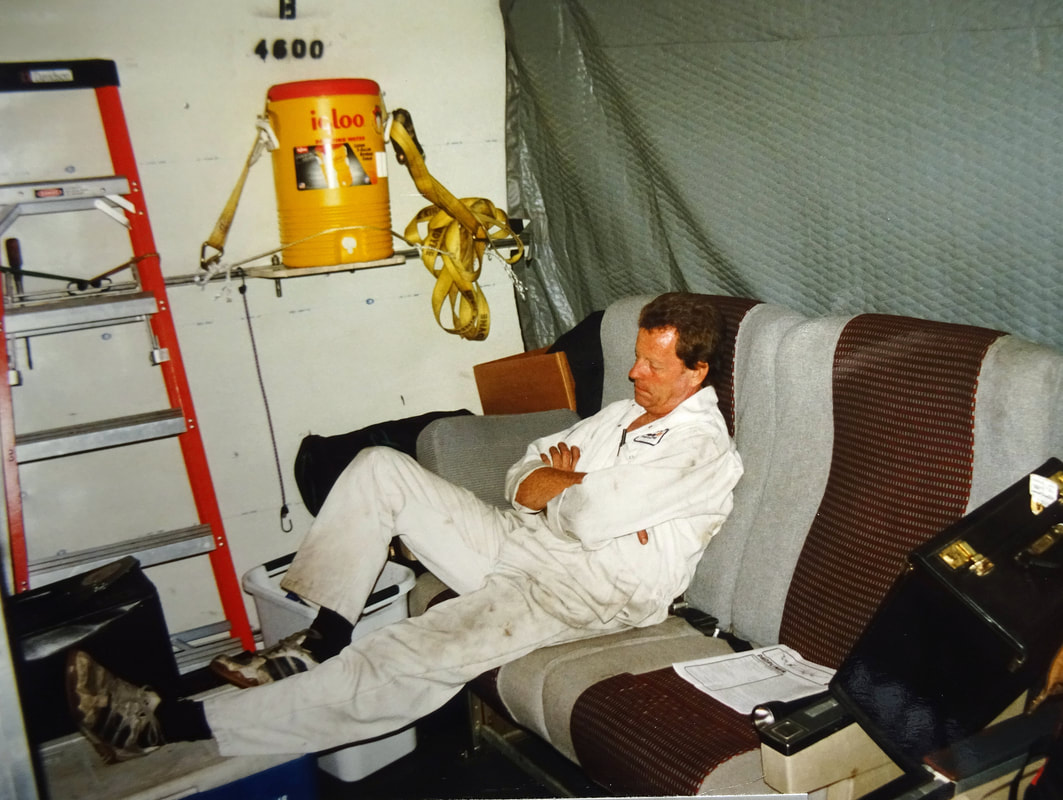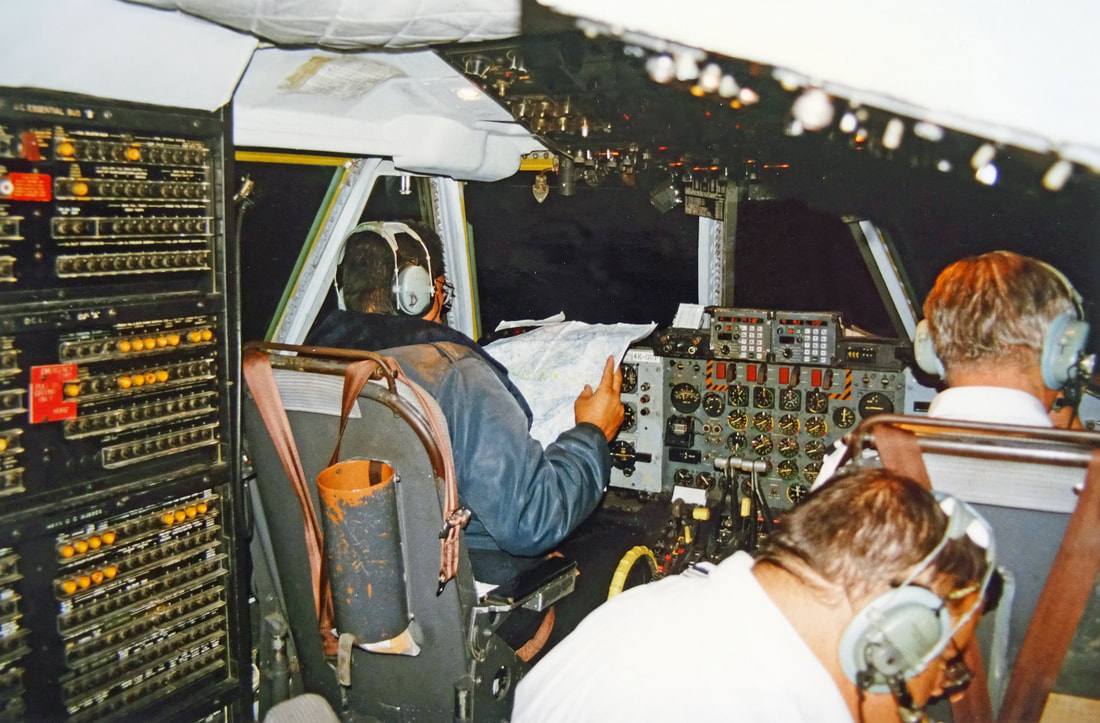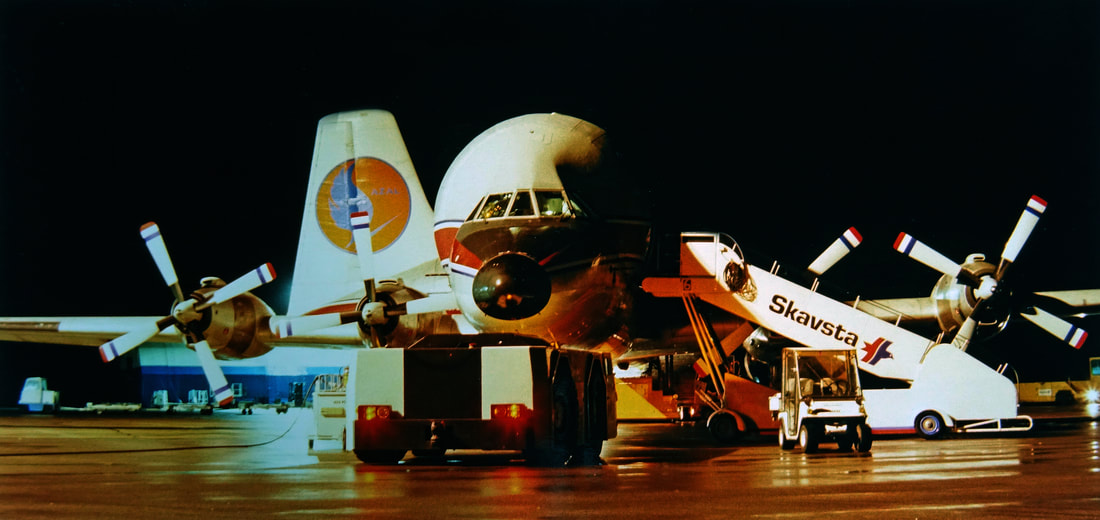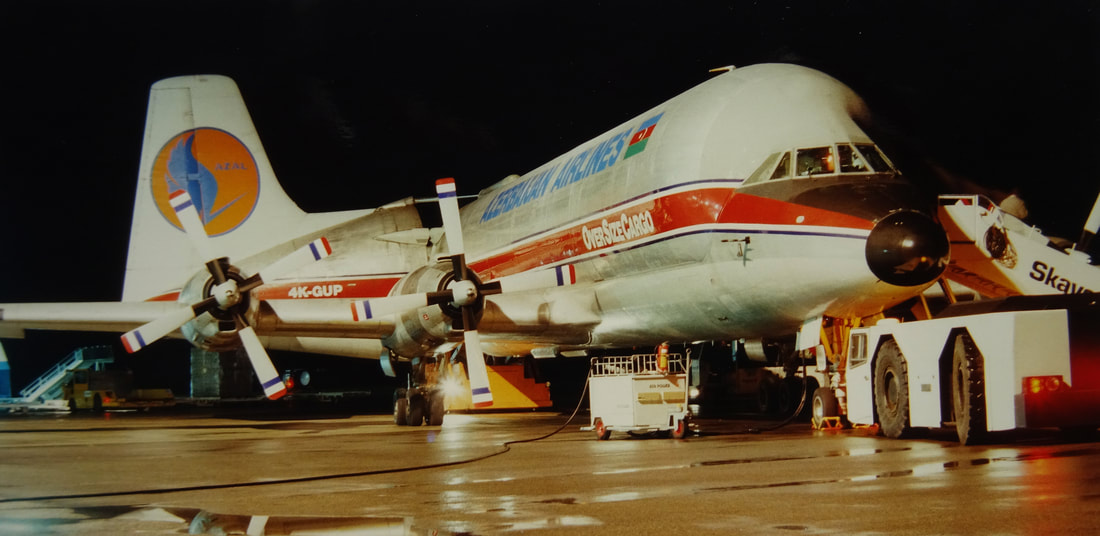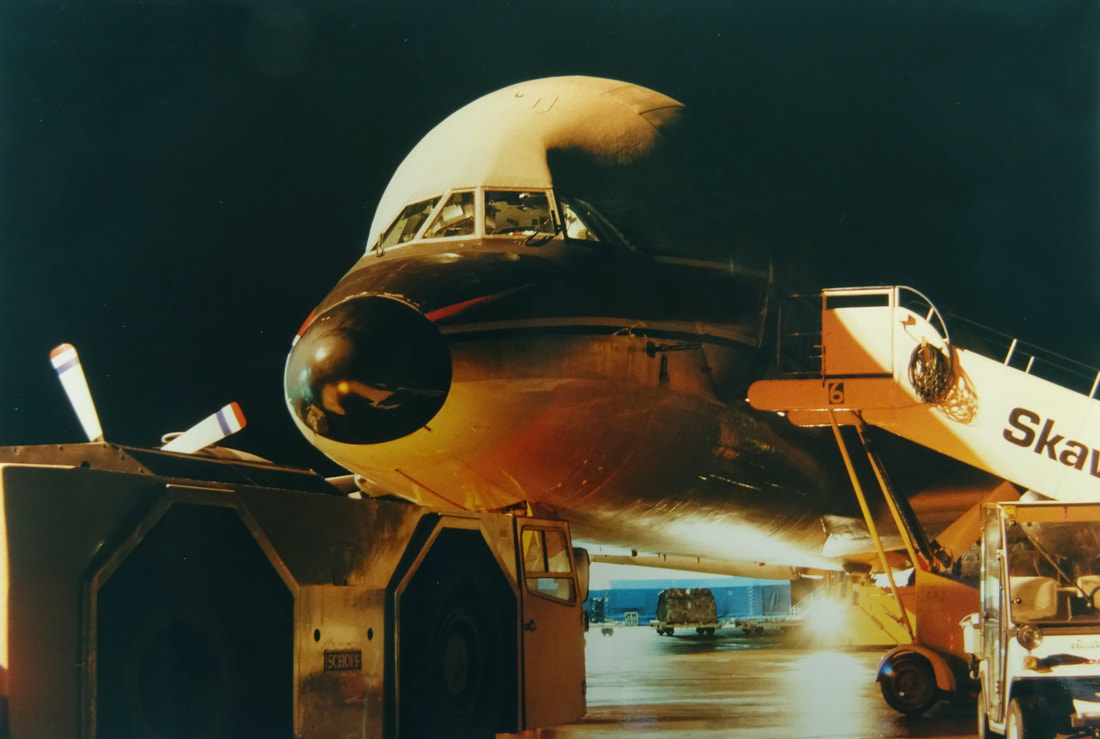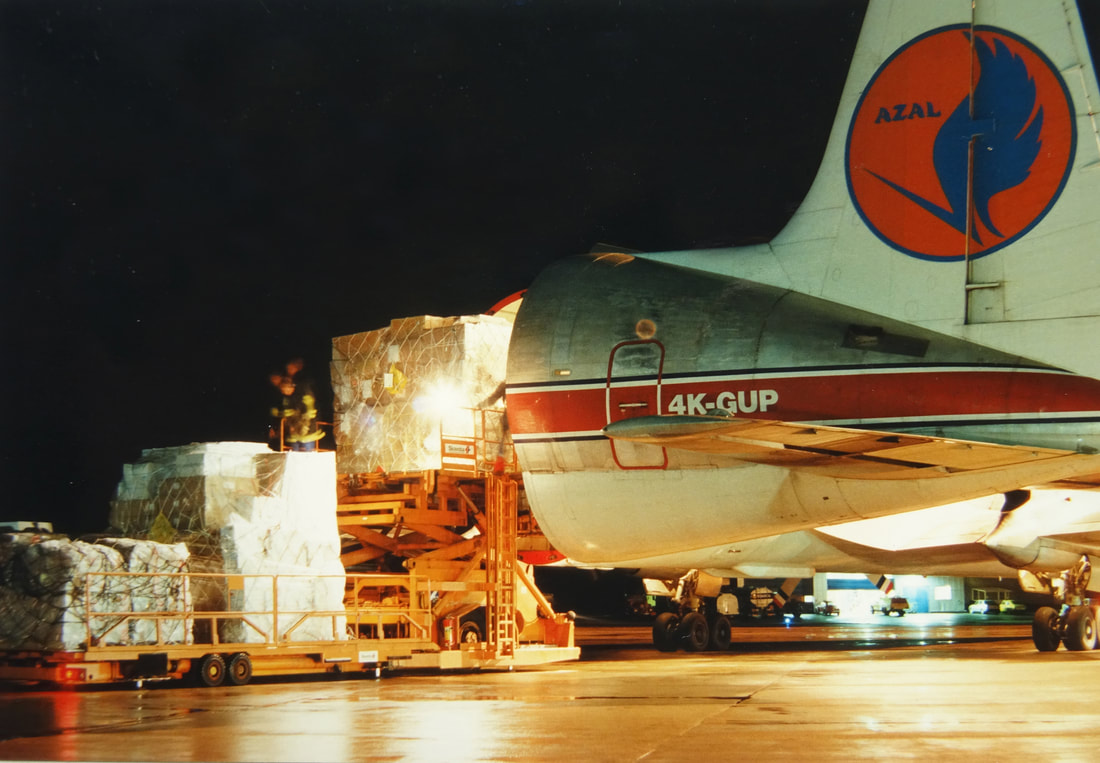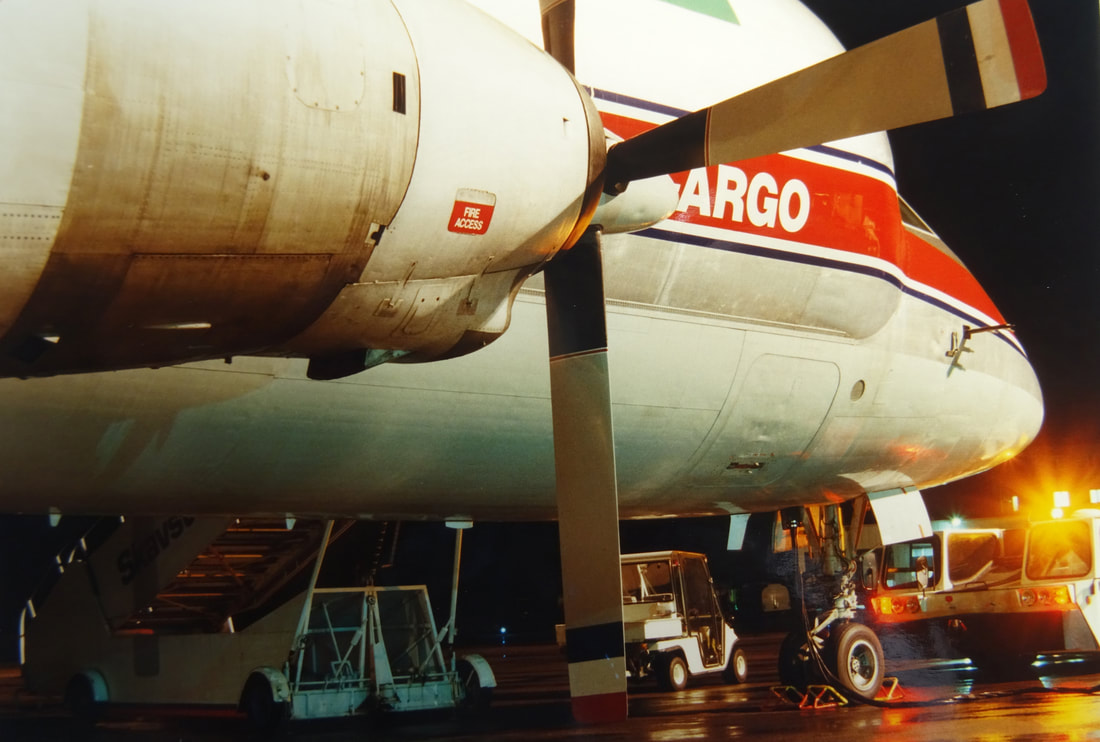KLM goes Guppy for a night
"Ride aboard the unique Conroy Guppy on a night flight deep into Europe"
by Jan Koppen
“Good news, the good old Guppy is back again”, read a Heavylift press release from September 1996. The company. specializing in the air transport of outsize items. offered their former Conroy Canadair CL-44-0 Guppy. a one of a kind conversion of the original CL-44D, for immediate availability to the airlines and cargo forwarders. Being an eye-catcher at every airport. the aircraft's I36-foot length. 142-foot wingspan and its large “bubble” fuselage gives the transport an imposing appearance. The Guppy's voluminous hold, including the lower deck compartment, can carry almost 13.000 cubic feet of cargo. With an impressive 56.000-lb. net payload. the Guppy is capable of carrying 5000 lbs. more freight than the Lockheed Hercules. Heavylift, which operates its Short Belfast for KLM Cargo on the daily night schedule to Stockholm Skavsta Airport, needed to replace the Belfast on short notice and on the evening of October 01, 1997, the Conroy Guppy was placed on the duty roster. In fact, the Guppy is owned by Azerbaijan Airlines from Baku, Azerbaijan, but is technically maintained, marketed and for this occasion, leased by Heavylift. The period of turboprop supremacy on KLM Cargo's Europa Freighter network is drawing nigh at this time of writing (1997), due to the introduction of Heavylift's capacious Airbus A300F on most routes of the network. Fortunately the whistling sound of Rolls-Royce Tyne and Allison engines will not completely disappear as the Short Belfast will still operate the nightly Amsterdam-Dublin round trip and the Schreiner L-382G on the nightly schedule to Manchester and Vienna. Due to this fact and the unique characteristic of the Canadair Conroy CL44-0 Guppy, l was keen to sample a typical cargo flight on the Guppy's run from Amsterdam to Stockholm Skavsta Airport as a cargo operation observer on the October 01, flight.
“Good news, the good old Guppy is back again”, read a Heavylift press release from September 1996. The company. specializing in the air transport of outsize items. offered their former Conroy Canadair CL-44-0 Guppy. a one of a kind conversion of the original CL-44D, for immediate availability to the airlines and cargo forwarders. Being an eye-catcher at every airport. the aircraft's I36-foot length. 142-foot wingspan and its large “bubble” fuselage gives the transport an imposing appearance. The Guppy's voluminous hold, including the lower deck compartment, can carry almost 13.000 cubic feet of cargo. With an impressive 56.000-lb. net payload. the Guppy is capable of carrying 5000 lbs. more freight than the Lockheed Hercules. Heavylift, which operates its Short Belfast for KLM Cargo on the daily night schedule to Stockholm Skavsta Airport, needed to replace the Belfast on short notice and on the evening of October 01, 1997, the Conroy Guppy was placed on the duty roster. In fact, the Guppy is owned by Azerbaijan Airlines from Baku, Azerbaijan, but is technically maintained, marketed and for this occasion, leased by Heavylift. The period of turboprop supremacy on KLM Cargo's Europa Freighter network is drawing nigh at this time of writing (1997), due to the introduction of Heavylift's capacious Airbus A300F on most routes of the network. Fortunately the whistling sound of Rolls-Royce Tyne and Allison engines will not completely disappear as the Short Belfast will still operate the nightly Amsterdam-Dublin round trip and the Schreiner L-382G on the nightly schedule to Manchester and Vienna. Due to this fact and the unique characteristic of the Canadair Conroy CL44-0 Guppy, l was keen to sample a typical cargo flight on the Guppy's run from Amsterdam to Stockholm Skavsta Airport as a cargo operation observer on the October 01, flight.
Guppy 4K-GUP moments before touchdown on runway 19R at Schiphol on August 25, 1997.
Special thanks to Ad-Jan Altevogt for driving us around in his airport authority van.
Special thanks to Ad-Jan Altevogt for driving us around in his airport authority van.
Guppy AZAL/001 taxies to its stand on Amsterdam Schiphol-East. The aircraft was positioned on the moring of August 25, 1997 from Southend-on-Sea, England, to Amsterdam from which the Guppy picked up relief supplies for Baku, Azerbaijan, for next night's flight.
With OverSizeCargo proudly emblazoned on its fuselage, the modified Canadair CL-44 is a unique sight.
CHECK-IN FOR SKAVSTA
That evening the Guppy had already been positioned from Southend to Amsterdam. Upon arrival, l found the Guppy on the brightly lit Bravo ramp still awaiting its load. On board, l introduced myself to the crew. In command of flight AHY491 was Captain Jose A. Munoz from Miami, Florida. Following several years as a pilot on the de Havilland Heron with San Juan-based Prinair, he moved on to fly CL-44’s at Tradewinds in the USA - a type on which he amassed a total of 7.800 flying hours. He also flew Milton Air B-707’s and DC-8’s, next going to Rich international’s L-1011’s. All in all, he clocked up a massive 18.000 hours of flying experience. In the right seat was First Officer Jerry Overcash of North Carolina. Jerry started his career with the US Navy as a mechanic on a US aircraft carrier. After 20 years of service he started his flying career on the CL-44’s of the US cargo airlines Wrangler and Tradewinds. He amassed more than 10.000 hours on the type. The Flight Engineer's position was occupied by Leslie Sawyer, also from North Carolina. Leslie flew C-130’s for the USAF and had been an instructor on the type with the Saudi Air Force. He also has a wealth of experience on the CL-44, with more than 8.000 hours on the type with Wrangler, Tradewinds and Buffalo Airways. Recently, Leslie ferried two stored (Tennessee) CL-44’s to the aircraft broker Trans Lloyd in South Africa. He also flew with the Guppy on several runs to Zaire and into Brazzaville, Congo, just prior to the civil war breaking out. For this flight, Heavylift supplied a flight mechanic and a loadmaster. Steve Dodson served as the mechanic, while Dave Swallow supervised the loading. Dave, a well-known personality to many of the KLM ground handling staff at Schiphol, started working in 1971 as a loadmaster on CL-44 at Transmeridian at Stansted, England. For a short period he worked for Cargolux on B-747F’s and DC-8s before being employed by Heavylift in 1983. He mainly worked on the Conroy Guppy during these years. On my question on what he thought about the Conroy Guppy he remarked. “l feel the Conroy Guppy is my home. l was brought up with her and, believe it or not, l do love her.” Quite a character, that Dave!
Dramatic shot of the Guppy running all four Rolls Royce Tyne engines under the bright glare of
Schiphol's ramp floodlights prior to departure to Skavsta on the KLM freight schedule.
Schiphol's ramp floodlights prior to departure to Skavsta on the KLM freight schedule.
READY FOR DEPARTURE
Despite being wedged in between company Belfast G-HLFT and a Southern Air Transport L-382G Hercules, the mighty Guppy dominated the brightly lid ramp. There was a hive of activity as numerous pallets were loaded under floodlight at near-frantic speed on all three aircraft. The Guppy took 20. 200 lb. of fuel and 43,000 lb. of general cargo, loaded on nine main deck pallets, which had been added to our basic operating weight of 104.200 lbs., giving the Guppy a take-off weight of 167,400 lb. - a long way below the maximum takeoff weight of 170.410 lb. The bulk of cargo filled the aircraft before the maximum weight limit was reached. We would burn an estimated 11.410 lb. of fuel en route to Skavsta Airport. Trailing behind Leslie on his walk-around inspection gave me the chance to inspect the Guppy at close range. Sporting a smart red ex-Buffalo Airways cheat line with large CL-44 Oversize Cargo titles in white, the Guppy wears bold Azerbaijan Airlines titles over the entire top fuselage. The swing tail is adorned with the artistic AZAL Cargo logo and the aircraft is appropriately registered 4K-GUP. The 38-ft tail towers over the nearby building and on the 142-ft span wing hang four 5730 shp. Rolls-Royce Tyne 515 engines. With the huge swing tail (11 ft. 4 in. wide) slowly closing into its locked position, we climbed up into the Conroy through the portside crew door and prepared for departure. With the flight crew strapped in on the rather cramped flight deck. caused by a far more cramped toilet situated inside the cockpit. we were set to go. With everything buttoned up, start-up clearance was received immediately.
Captain José Munõz and his crew take a break form the check-list, to pose for the author's camera.
INTO THE NIGHT SKY
At exactly midnight. Jose called for engine start on number one, followed by two, three and four. With the crew door still open. The large 14 ft. 6, in. propellers of number one Tyne, flashed and an incessant whine pushed the upper limits of hearing tolerance. With all four up and spinning smoothly, we were pushed back and disappeared from the bright ramp into the darkness. Disconnected from the tug we weaved our way through the maze of green, white and blue lights toward runway 24. During the course of its mile long taxi, the crew prepared for takeoff, with a seemingly endless succession of checklists to wade through before we reached the threshold. With Captain Munoz flying the first section, his fingers were dancing among the shiny switches and levers to adjust the power settings of the Rolls-Royce engines. With all checks satisfactorily completed, we were cleared for takeoff at 0016. As Jose eased the throttles forward, the quartet of Tyne 515’s accelerated into an impressive high pitched concerto. Alto Hotel Yankee 941 sped down the runway. On reaching 120 knots and after a ground roll of little more than 4.000 feet, our bulbous Guppy lifted into the clear night sky. There was no sensation of rotation, we just seemed to rise suddenly upward! With the landing gear safely up and locked. we began a slow, lumbering climb to our cruising level of FL190. Amsterdam radar handed us over to Bremen control and with the Tynes settling into a deep contented hum we sailed, with a respectable ground speed of 310 knots, serenely northward to our designated waypoint of Helgoland. Total flying time from Amsterdam to Skavsta Airport was estimated at 2:15 hours.
“l feel the Conroy Guppy is my home. l was brought up with her and, believe it or not, l do love her.” - Quite a character, that Dave!
At the next position report, the crew came out of its self-induced trance. Coffee cups were refilled and the conversation fumed to the history of AK-GUP. In its 36-year life span (in 1997), the aircraft has labored all over the world. Being built for Flying Tigers in 1961, CL-44D c/n. 16 was bought by Jack Conroy Aviation of California and converted into a special Guppy version designated the CL-44-0, for carrying Rolls-Royce RB-211 engines to Lockheed for the L-1011 program. The upper fuselage was removed and replaced by an enlarged section that raised the cabin height by about 5 feet and it first flew in this modified form an 26 November 1969. Leased by British Transmeridian in 1970, the Guppy, still maintaining its US registration N447T, was christened with the name Skymonster. Offering almost double the volumetric capacity of the standard CL-44D, with the ability to carry 13,000 cubic feet of cargo, the Guppy became a favorite of outsize cargo forwarders. During 1978, Transmeridian merged with lAS and become British Cargo Airlines. This company filed for bankruptcy in 1980 and the Guppy was passed to Heavylift which registered the plane as El-BND in 1983. After 13 years of trustful service, in which the Guppy also operated four flights for KLM Cargo during November 1992. the transport was sold to Buffalo Airways of Canada in 1993 and based in Miami. Life with Buffalo was a short three years before the Guppy was withdrawn from use for 18 months in Tennessee. Last spring, the Guppy was sold to Azerbaijan Airlines. Totally, our Canadair CL-44, of which only 39 were build, has notched up 52.000 flying hours. By now CL-44’s are an endangered species. Exactly 38 years after the types first flight. only three operational aircraft remain in service.
THE LANDING
A little under two hours after leaving Amsterdam, AHY941 was ready for descent into Skavsta Airport. A few minutes later we reached Trosa, a navigational beacon on the Swedish eastern coastline. We changed our heading and requested approach for a straight-in landing. Soon after the crew started their pre-landing checklist, we slowly began to decrease our speed and height. As we broke through the heavy cloud cover, we immediately spotted the brilliant lights of Skavsta's runway 27 located in a black pool of darkness. Moments later the gear was dropped from its bays with a low thump and clicked into its locked position. As we got closer, Jose adjusted the aircraft's attitude for a good runway alignment. With all the landing checklist items ticked off and the engines throttled back, we glided over the threshold. Jose placed the Conroy's mainwheels firmly onto the slick concrete, almost halfway down the runway. But the massive de propellers went into reverse pitch immediately, and slowed us to taxi speed with ample room to spare.
SUBHUB ACTIVITY
Slowly we backtracked the runway toward the KLM Cargo warehouse. Seconds after 4K-GUP's immense props stopped turning, the large swing tail was opened and the unloading process swung into gear. Outside the weather was dreadful, drizzle mixed with patches of thick gray fog slowly drifted across the brightly fit ramp. Stockholm Skavsta Airport, a former Swedish air force base, is a quiet place during the night. The underutilized airport, situated 80 miles south of Stockholm, was selected by KLM due to the fact that a major client has its factories in close proximity. By 0425, our 44,000 lb. of return cargo was safely on board. thanks to the efficiency of KLM cargo manager John and his ground staff.
4K-GUP with her swing-tail open, taking on cargo at Skavsta on the night of October 02, 1997.
Ride aboard the unique Conroy Guppy on a night flight deep into Europe.
The Swing tail helps easy loading and unloading.
Azerbaijan Airlines Conroy CL-44-0 4K-GUP almost ready for push-back at Skavsta on October 02, 1997.
BACK TO AMSTERDAM
Engines were started at 0430 and five minutes later, Alfa Hotel Yankee 942 taxied to the runway 09 threshold. We were immediately cleared for departure and with Jerry at the controls for the return sector, our Conroy Guppy again sauntered into the air. 4K-GUP was soon on course toward the Alsie VOR on the Danish island of Als. One hour and 50 minutes into flight while cruising at 21,000 ft over the Helgolander Bucht, Dutch ATC broke the silence on the flight deck with clearance to descend. As the throttles were pulled back and we made a gradual right—hand turn skirting the top of an ominous CB, flickering lights were momentarily visible indicating the Dutch coast. Soon we were being vectored for an ILS approach to runway O6 at Schiphol by a detached Amsterdam controller. Passing over the outer marker, Jose selected gear down and seven minutes ahead of schedule, our venerable Guppy glided ponderously onto 06's concrete. 4K-GUP shuddered to a noisy stop as the props were thrown into reverse and we vacated the active runway immediately. As we were taxiing to the freight apron, l asked Jose what he thought of flying the Guppy. “The Guppy certainly has some unique habits - flying it is a combination of craftsmanship and artmanship", he remarked. As we followed the yellow marshall 's van to the stand, we were met by a group of KLM ground handlers, eager to unload our silver workhorse bang on schedule and then be off home to a warm bed.
Postscript; - l know this pristine veteran will not soldier on forever but hopefully this unique propeller-driven airliner will earn its keep for many years to come.
After the Guppy Capt. Munoz was typed rated in the B-757, B-767. Also rated as a Turbojet Flight Engineer. All this training was part of a job with the Federal Aviation Administration. Several years ago, Capt. Munoz retired from the FAA as a Operations Safety Inspector for the AMR CMO in Dallas for American Airlines in Miami and as an Operation Safety Inspector for the Miami/Miramar Federal Aviation International Field Office.
Last year Capt. Munuz retired as an aviation consultant.
As per F/E Leslie Sawyer, Capt. Munoz lost contact with him many years back.
Mr. Overcash still lives in North Carolina.
- The End -
